Author: ELAINE HU, Cointelegraph
Translated by: Tim, PANews
The cryptocurrency market has witnessed a significant adoption of automated trading solutions, with trading bots becoming increasingly prominent due to their ability to analyze vast amounts of data and execute trades with precision.
This article delves into the historical performance of trading bots in relation to the volatile price movements of tokens, and through backtesting strategies against a "buy and hold" benchmark, decodes which bots have performed best during specific market cycles and their standout moments, helping you match the best trading bot according to your investment style and risk tolerance.
This article examines three types of trading bots: Telegram-based DEX trading bots; non-Telegram bots trading on DEX and centralized exchanges; and the recently evolving AI agent bots.
Choosing the right trading bot requires consideration of the user's goals, risk tolerance, and experience.
In short:
Telegram bots are well-suited for opportunistic trading scenarios that require quick reactions and timing, such as token launches and meme coins.
AI agent bots (such as ai16z or Virtuals) are suitable for users looking for fully automated operations and willing to experiment with experimental strategies.
Centralized exchange bots offer the greatest control, especially for executing structured strategies such as dollar-cost averaging (DCA), grid trading, or signal-based trading.
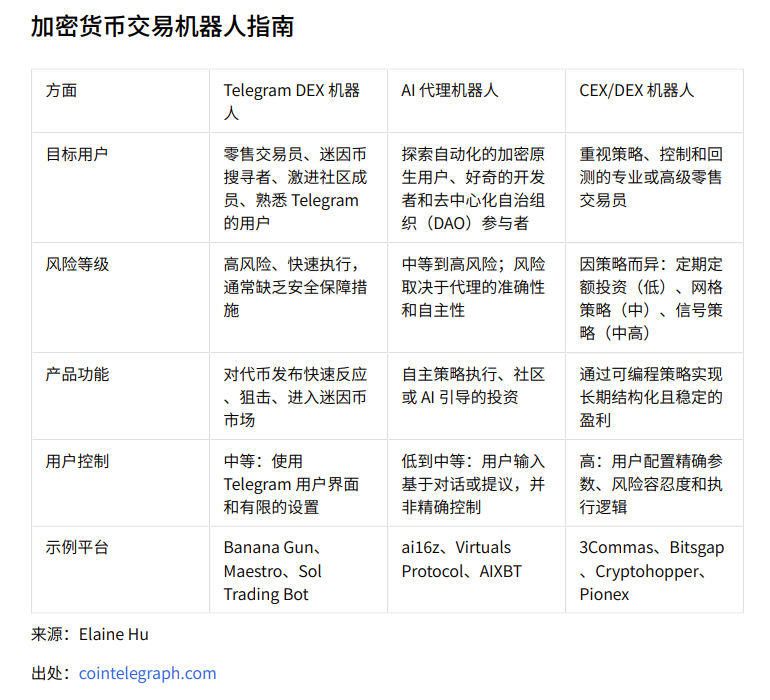
Bot Trading Strategies and Performance
Trading bots are complex automated systems that analyze cryptocurrency market data through algorithms and autonomously execute trades on centralized exchanges or decentralized platforms. These systems typically operate 24/7, requiring minimal human intervention. Their core function lies in analyzing vast amounts of real-time and historical market data, including price fluctuations, trading volumes, and order book information.
Using AI agent trading bots has numerous potential advantages. Their continuous operation ensures that no trading opportunities are missed, as these bots can monitor the market around the clock, adapting to the dynamic changes of the global market. Some platforms offering such bots also feature backtesting capabilities, allowing users to evaluate the potential effectiveness of different trading strategies using historical data before committing real funds to actual trading.
Telegram DEX Bots
Telegram trading bots operate on the Telegram platform, leveraging its convenience and real-time communication advantages to execute trades directly on decentralized exchanges. These bots typically focus on enhancing trading speed and seizing new token launches, particularly attracting users from ecosystems like Solana. Newly launched protocols have also integrated features commonly found in centralized exchange trading bots, such as grid trading, dollar-cost averaging (DCA), and limit order strategy tools.
Telegram bots, such as Maestro and Unibot, first emerged around 2020 to 2021. By 2022, many of these bots began offering advanced features like copy trading and arbitrage.
By the end of 2023, trading bots based on the Solana chain (such as BONKBot and Trojan Bot) gained attention for their ability to quickly trade meme coins on decentralized exchanges. The biggest advantage of these Telegram bots is that users can complete trades directly on their mobile devices without needing to connect their wallets through browser plugins. This feature greatly optimizes the ease of mobile trading while enhancing market monitoring capabilities and seamless integration with social networks.
Based on historical trading volume, the top five Telegram bots across blockchains are Trojan, BonkBot, Maestro, Banana Gun, and Sol Trading Bot. Over the past 90 days, the vast majority of trading volume occurred on the Solana blockchain, with all five top Telegram bots operating on the Solana chain.

The Battle of DEX Trading Bots Source: Dune Analytics
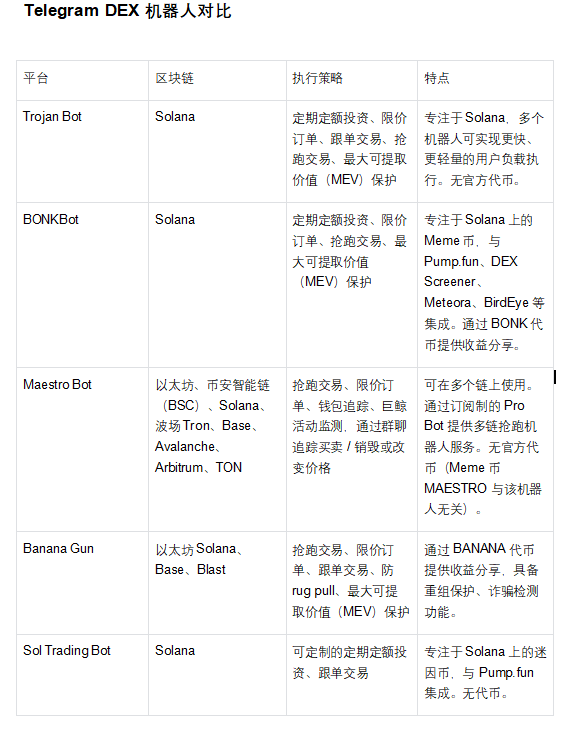
The functionalities offered by Telegram bots are quite similar, with some (like Maestro and Banana Gun) focusing on multi-chain operations, while others concentrate on the Solana chain.
The primary use of Telegram bots is to automatically identify profitable entry and exit points for trades and execute them quickly; however, due to the difficulty in tracking individual user profits and losses from each trade, some Telegram bots (like Banana Gun and BonkBot) use a revenue-sharing model tied to their tokens, repurchasing their own tokens with a 1% fee collected, using token price and protocol revenue (fees collected) as approximate indicators of market performance.
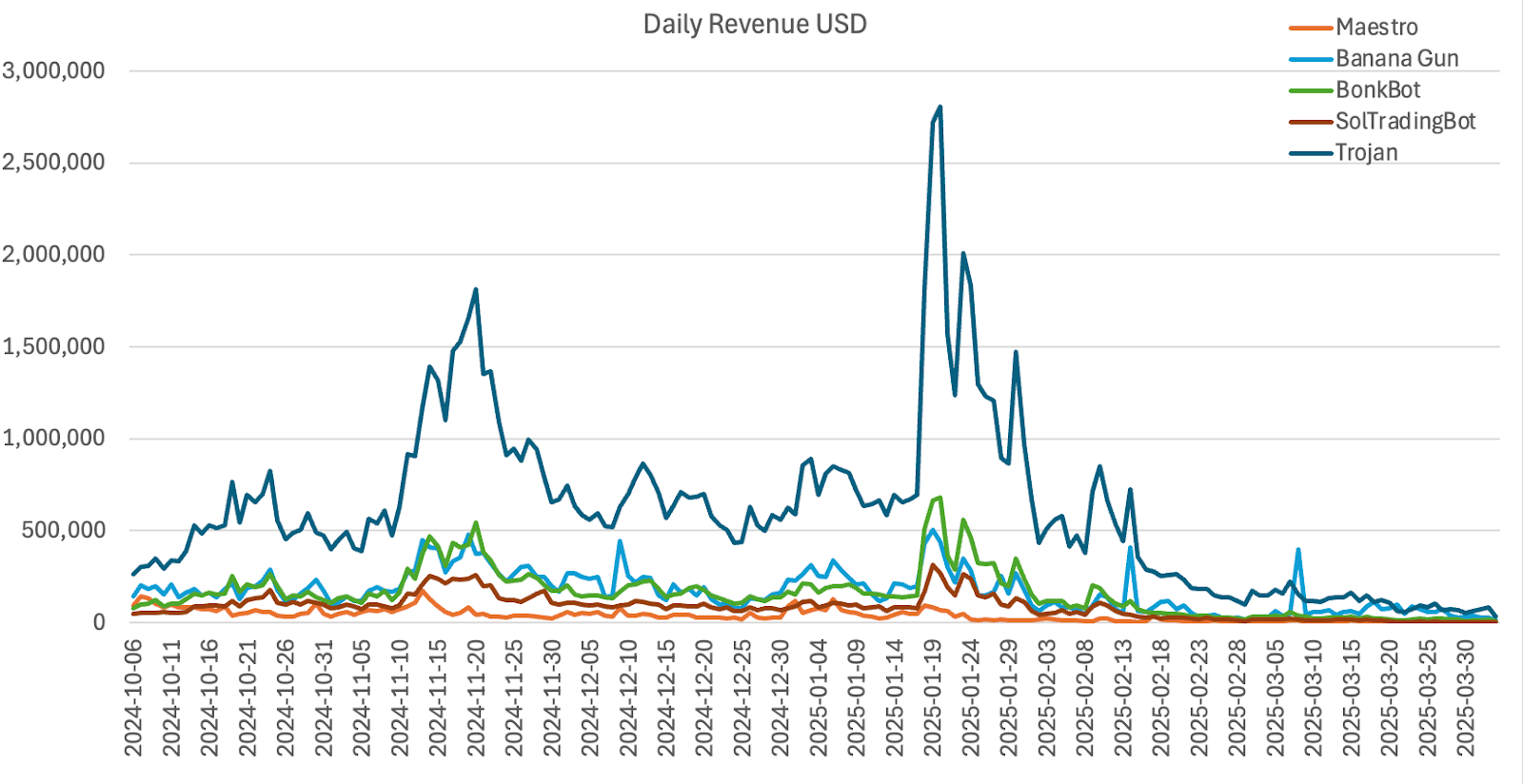
Daily Revenue of Telegram Bots (USD) Source: Dune Dashboard
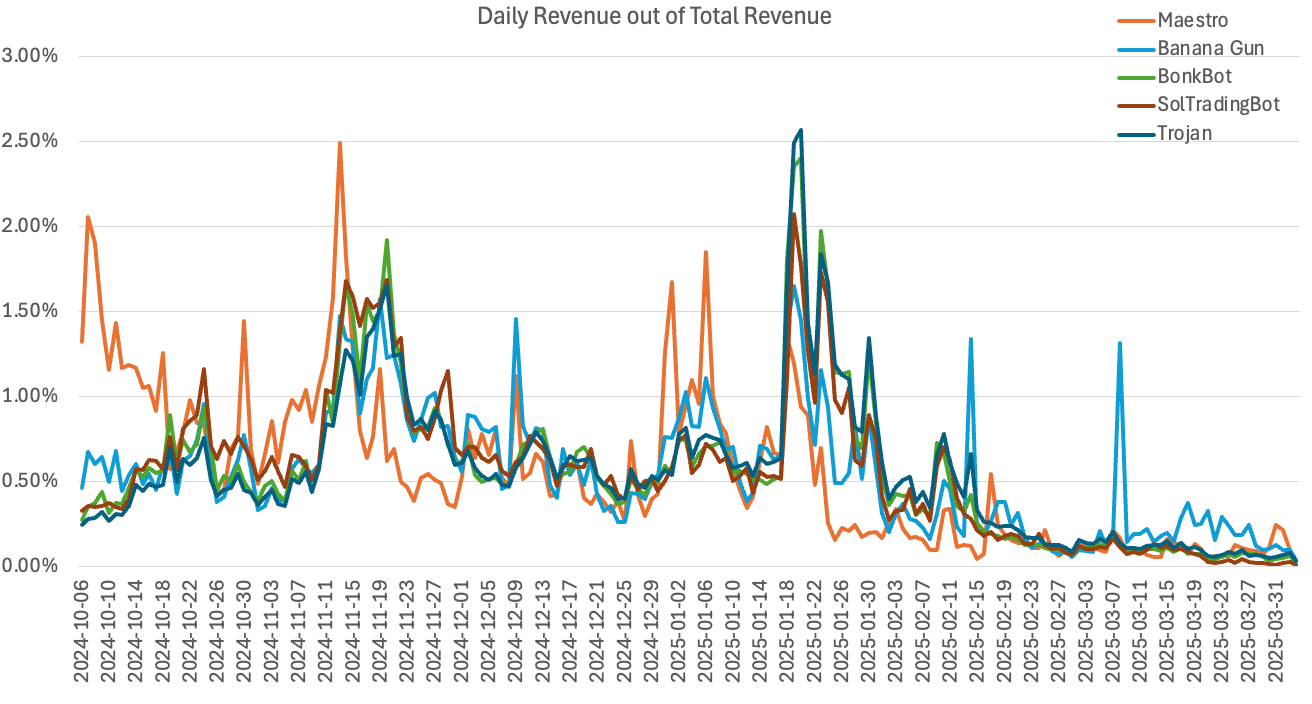
Proportion of Daily Revenue to Total Revenue Source: Dune Dashboard
Telegram DEX Bot Revenue Situation Over the Past 6 Months
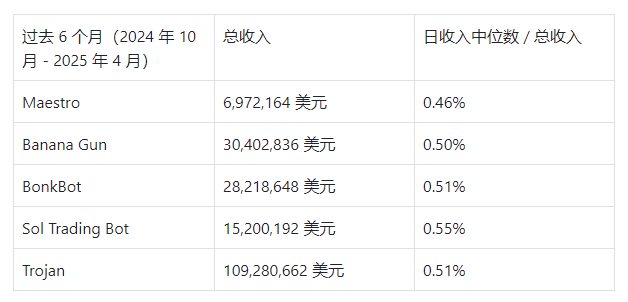
In terms of overall revenue over the past six months, Trojan had the highest nominal fee amount (approximately $109 million), while Sol Trading Bot performed best in terms of median daily revenue normalized by total revenue.
Both peaked during the meme coin frenzy around January 2025, but are currently facing a sharp decline in revenue due to a broader market downturn.
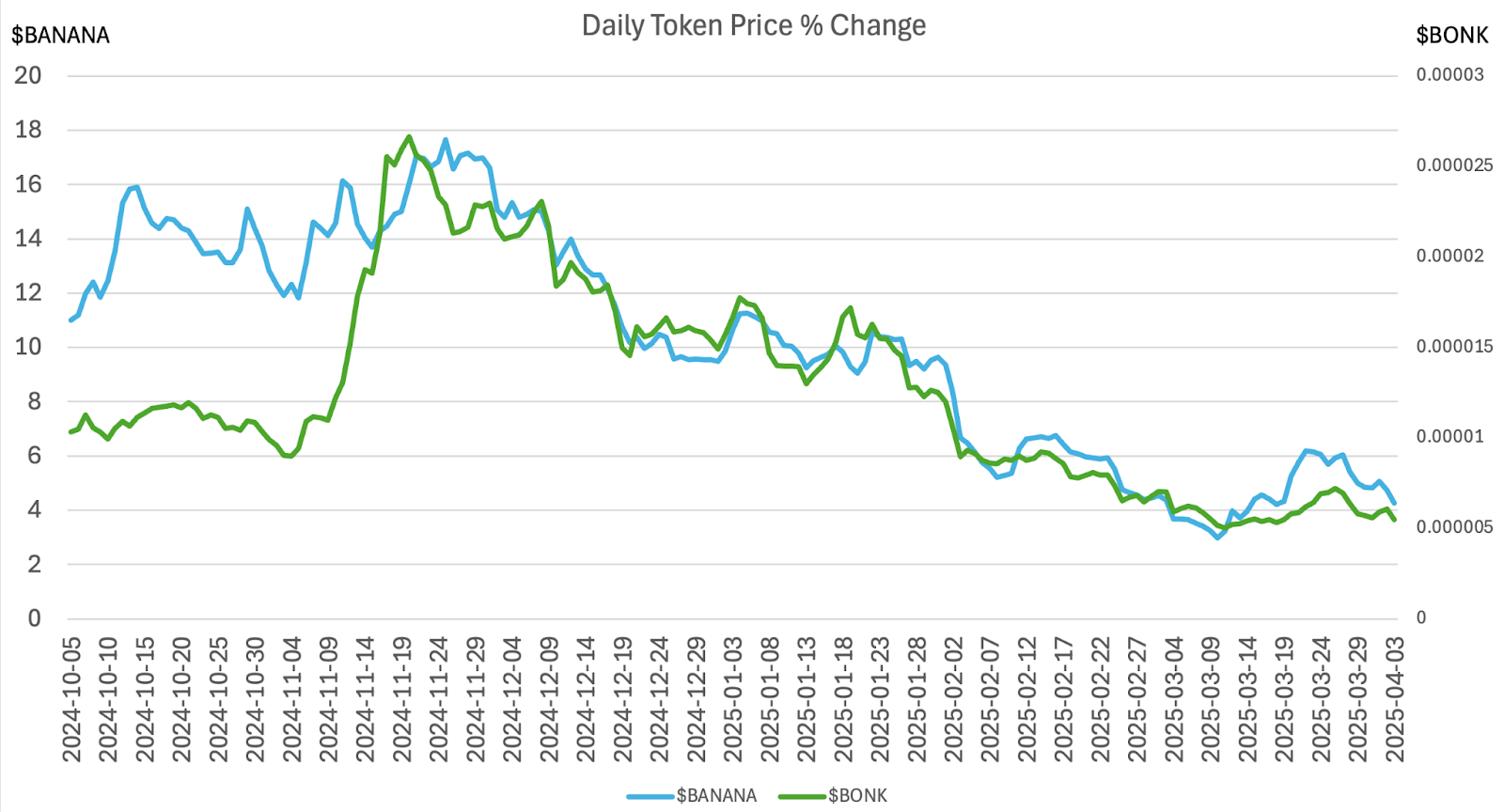
Percentage Change in Daily Token Prices Source: Dune Analytics
BANANA and BONK Token Price Performance

The price trends over the past six months show that, aside from a significant increase in the BONK token in November 2024, the other two Telegram bots, Banana Gun and BonkBot, which share revenue through tokens, performed very similarly. In the recent bearish market environment, both experienced significant price declines.
AI Agent Bots
AI agent trading bots are highly complex automated systems that utilize artificial intelligence (AI) and machine learning (ML) algorithms to analyze cryptocurrency market data and autonomously execute trades.
The term "agent" indicates that these bots possess a degree of autonomy and decision-making capability, surpassing the fixed-rule operations of traditional automated trading systems. The most well-known AI agent frameworks currently are Virtuals and ai16z.
Comparison of AI Agent Bots

The Virtuals Protocol was launched in October 2024 on the Ethereum Layer 2 network Base, serving as a platform for generating AI agents aimed at simplifying the creation and deployment processes of AI agents on the blockchain. Although the protocol is not specifically designed for trading, its platform supports the development of AI agents that may be used for trading purposes. For example, the experimental AI agent Aixbt on the platform can track trending discussions on social media X, identifying potential market signals through user dialogue analysis to generate strategy suggestions that assist trading decisions.
Since the Virtuals protocol adopts a LaunchPad model, where various agents (like LUNA and AIXBT) are issued as independent tokens and operate across different fields such as gaming, trading, and entertainment, we will focus on analyzing the market performance of the trading agent token with the largest market capitalization on the platform: AIXBT.

AIXBT Price History Source: CoinMarketCap
Ai16z is an AI-driven trading fund operating on the Solana blockchain. Launched in October 2024, the fund utilizes complex AI agents built on the Eliza framework to autonomously analyze market information such as price fluctuations, social media sentiment, and on-chain data, and to automatically execute trading decisions.
The fund operates as a decentralized autonomous organization (DAO), allowing its native token holders to participate in key governance decisions through voting and to influence trading strategies via a "virtual trust market." The virtual fund manager AI Marc, built on the Eliza framework, is responsible for managing the fund's trading activities. The AI16Z token represents ownership of the fund and grants governance rights, with the operations of its agents directly impacting the token's value.

AI16Z Price History Source: CoinMarketCap
By comparing the trading volume data of these two agents, it can be observed that both peaked in January 2025, with AI16Z recording a trading volume of $501 million, while AIXBT set a higher record with $682 million. Notably, the price peak of AI16Z occurred slightly earlier than its trading volume peak, whereas the price and trading volume peaks of AIXBT were essentially synchronized during the same period, indicating a closer correlation in the time dimension.
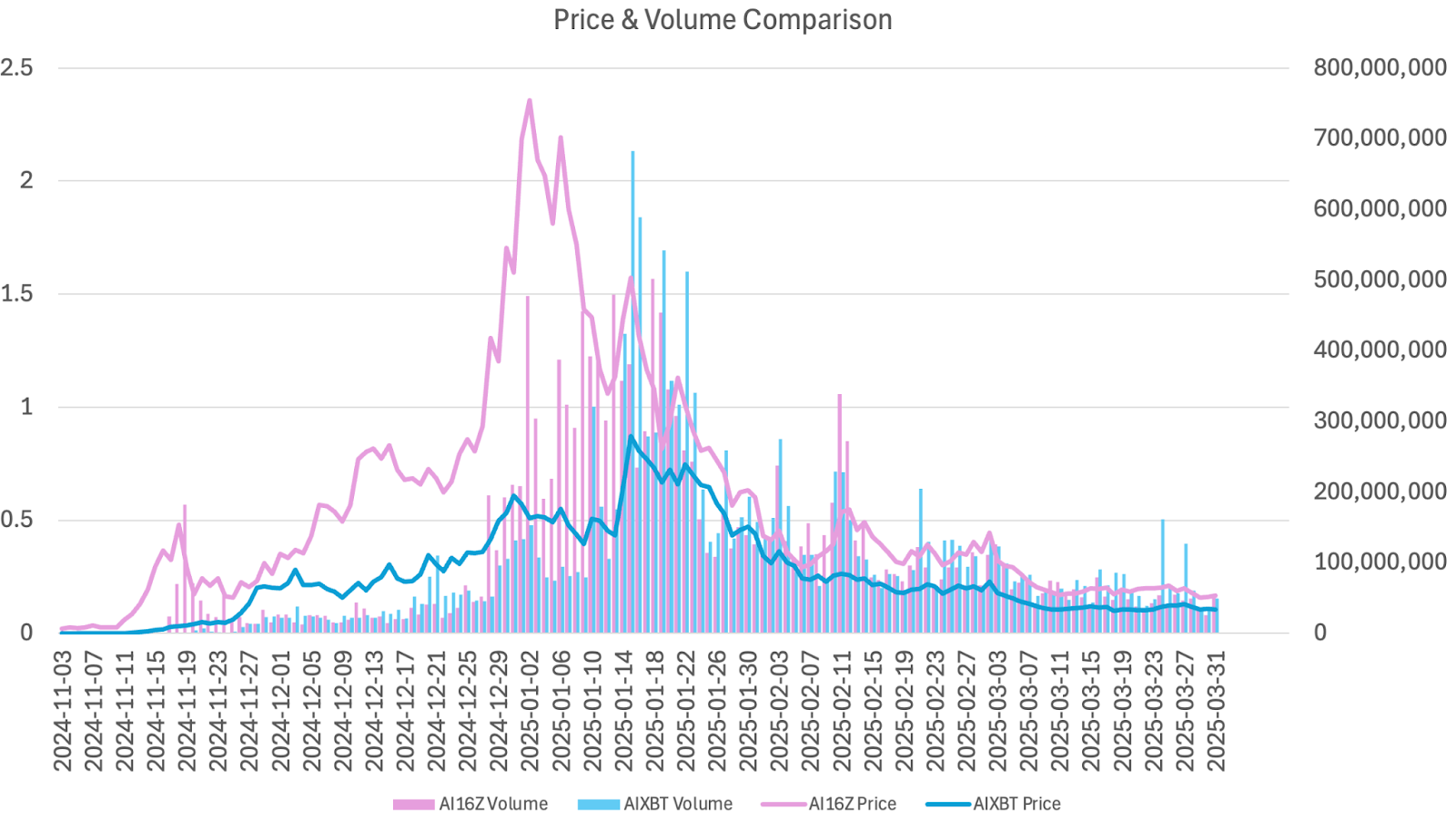
Comparison of AI16Z and AIXBT Prices and Trading Volumes. Source: CoinMarketCap
AI16Z and AIXBT Price Performance
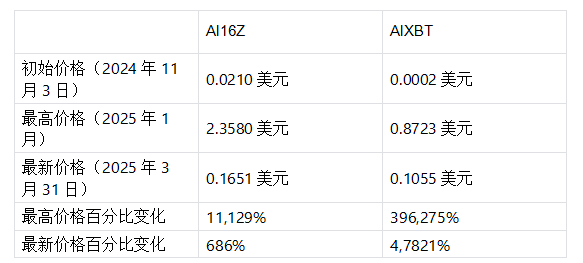
AIXBT's price performance has been more impressive than that of AI16Z. During the peak period in November 2024, its token price surged nearly 4,000 times from the initial issuance price, while AI16Z only reached about 111 times the increase during the same period. Even after experiencing a recent decline and with the overall market in a downward trend, the latest price record as of the end of March 2025 shows that AIXBT still maintains a 478-fold increase from its initial price, while AI16Z remains at a level of 6.8 times.
DEX/CEX Bots
These platforms are web-based and operate independently of Telegram. Users can trade directly on DEX by connecting their wallets or interface with CEX through API or simple login methods, all of which are part of the integrated exchange solutions offered by the platform.
These web-based platforms provide a wide range of strategy options and broader market access channels, balancing user demands for CEX liquidity and reliability with the non-custodial and decentralized features of DEX. Some platforms also support quick switching between DEX and CEX with a single click, making it easier to capture price differences between centralized and decentralized exchanges (i.e., CEX-DEX arbitrage opportunities).
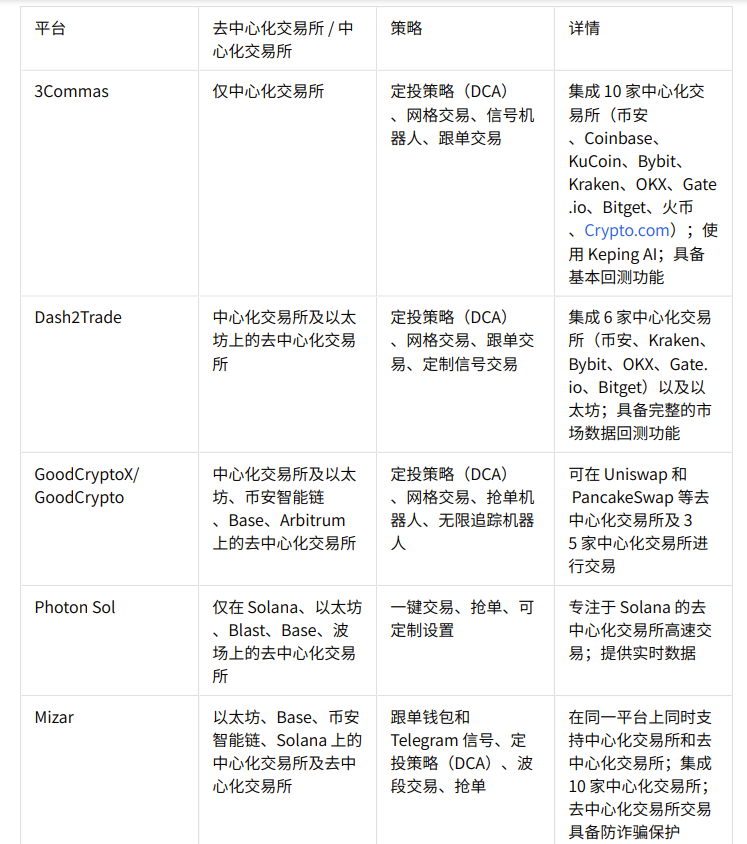
The most common strategies on these platforms include grid trading, dollar-cost averaging, and signal bots. Dollar-cost averaging bots invest a fixed amount of funds into cryptocurrencies at regular intervals, regardless of price fluctuations. The core idea of this strategy is to spread entry points over time, thereby reducing the impact of market volatility. Such strategies often perform well in markets with clear price trends.
Grid trading bots are designed for active trading, profiting from structured low-buy high-sell strategies. These bots place a series of limit buy and sell orders above and below a preset price range, creating an "order grid." Each completed low-buy high-sell cycle generates profit, and this strategy excels in sideways and highly volatile markets.
Signal trading bots execute trades based on external signals, which typically come from technical indicators, market analysis, or third-party services. Common signal indicators include the Relative Strength Index (RSI), Exponential Moving Average (EMA), and Bollinger Bands.
Comparison of Different DEX/CEX Strategies
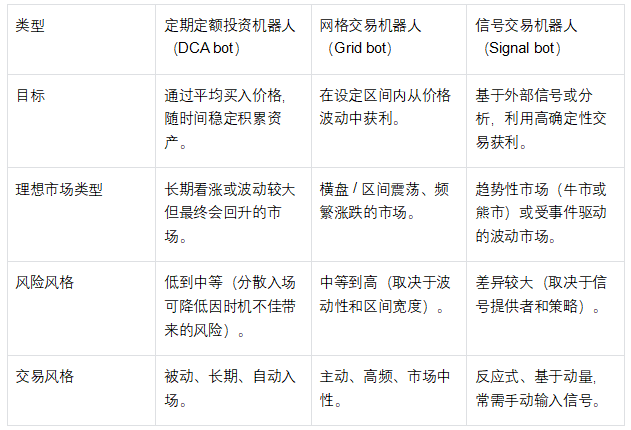
The following table shows the historical performance of the BTC/USDT, ETH/USDT, and SOL/USDT trading pairs under three trading strategies. For the grid trading bots, the parameter selection used the AI optimization feature built into the 3Commas platform to automatically select the best parameters; for dollar-cost averaging, the most popular classic trading strategy among users of the platform was adopted.
For signal bots, Dash2Trade provides a strategy preset feature, where the system automatically selects the optimal strategy for each token. These strategies are based on a self-developed trading system that has been backtested historically and applied to real market trading, but the validity of the strategies is limited to a trading period of 120 days prior to January 26, 2025.
Due to the lack of consistent available data across platforms, we adopted three backtesting periods for each strategy. The table below shows the simple price changes during the corresponding periods, which also represent the return rate of a simple buy-and-hold strategy.
DEX/CEX Bot Strategy Performance
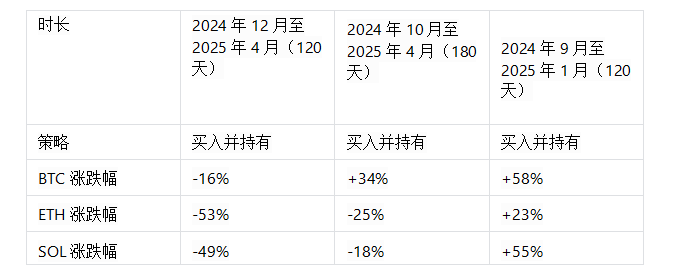
Existing data indicates that the performance of trading bots can vary significantly, depending on the specific trading bot used, the trading strategy employed, and the market conditions at the time of backtesting.

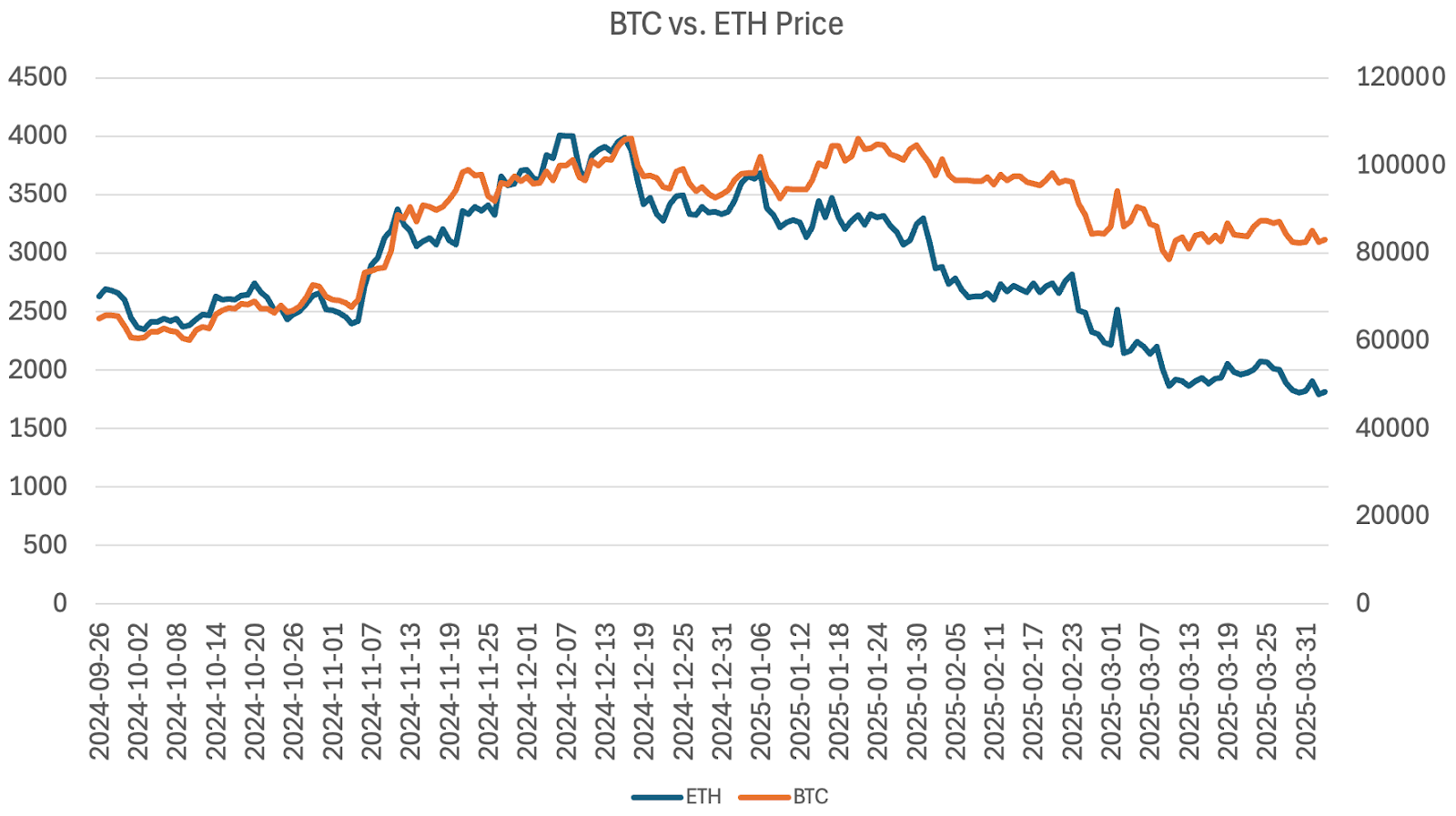
Bitcoin and Ethereum Prices Data Source: CoinMarketCap
During the 120-day backtesting period from September 26, 2024, to January 26, 2025, Bitcoin, Ethereum, and Solana all showed an upward trend, with buy-and-hold return rates of 58%, 23%, and 55%, respectively. During this period, the performance of the signal bot strategies was roughly on par with the buy-and-hold strategy (with some tokens slightly underperforming), specifically: Bitcoin strategy return rate of 58.15%, Ethereum strategy 16.79%, and Solana strategy 48.68%.
In the same 120-day period from December 4, 2024, to April 4, 2025 (during which the grid bot strategy was backtested), the market prices of Bitcoin, Ethereum, and Solana all showed a downward trend, with buy-and-hold return rates of -16%, -53%, and -49%, respectively. This was in stark contrast to the market environment of the previous 120-day backtesting period. In a clearly downward trend with significant market volatility, the grid bot strategy significantly outperformed the buy-and-hold strategy, generating positive returns of 9.6% for BTC, 10.4% for ETH, and 21.88% for SOL.
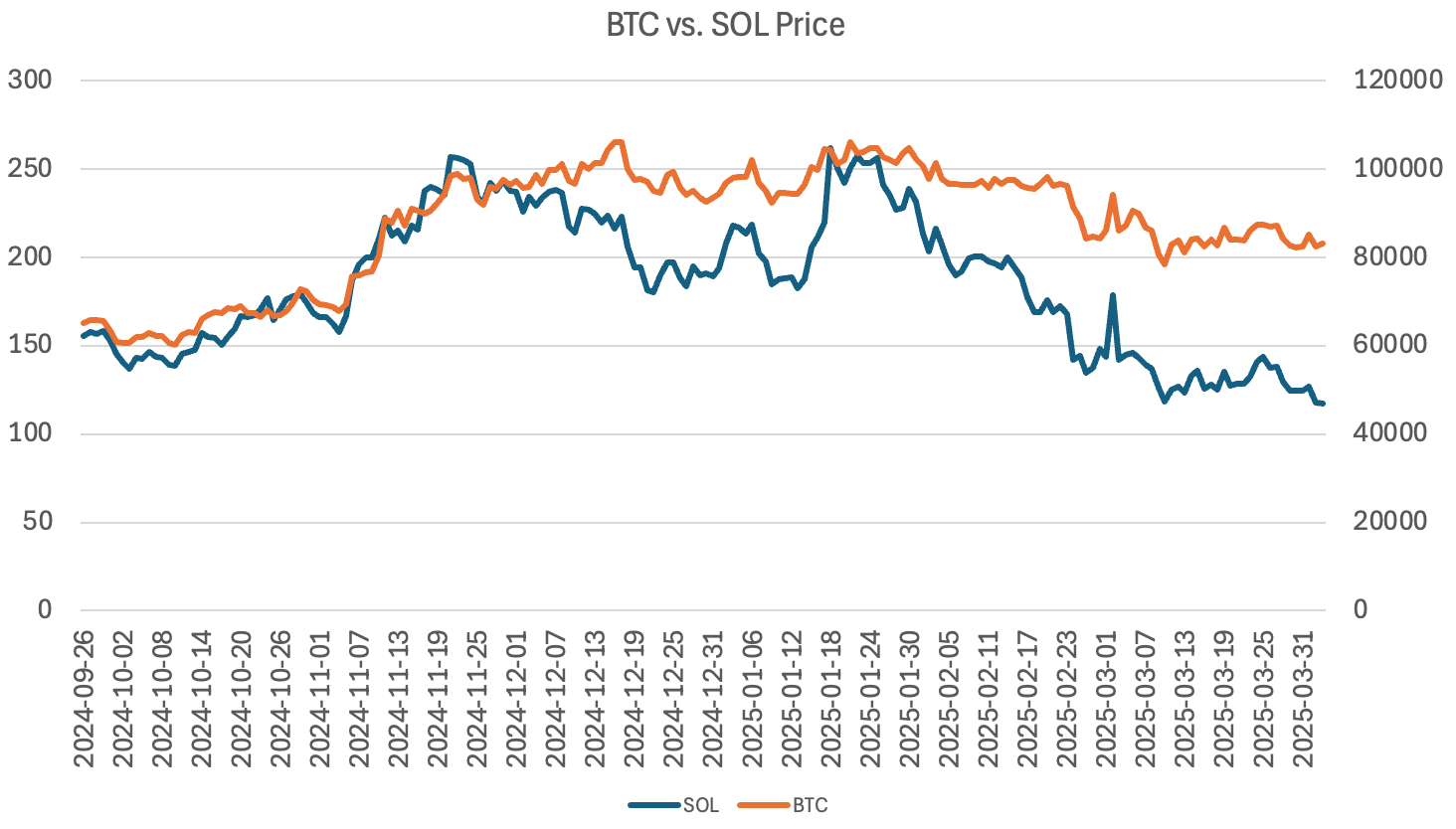
Bitcoin and Solana Prices Data Source: CoinMarketCap
In the longest 180-day backtesting period from October 4, 2024, to April 4, 2025, when backtesting the dollar-cost averaging bot, the buy-and-hold return rates for Bitcoin, Ethereum, and Solana were 34%, -25%, and -18%, respectively. In contrast, the performance of the signal bot strategies for these three tokens was markedly different from the buy-and-hold strategy.
For Bitcoin, the DCA bot achieved a return rate of 17.75%, underperforming the one-time buy-and-hold strategy. However, the DCA returns for Ethereum (ETH, 58.12%) and Solana (SOL, 80.92%) significantly outperformed the one-time investment. This difference may stem from the significantly higher volatility of ETH and SOL compared to BTC during the statistical period, with the DCA strategy effectively reducing timing risk by spreading investments over time and diversifying entry prices.
Comparison of Trading Bot Performance
Over the past six months, DEX bots like Trojan and Sol Trading Bot have dominated in revenue performance. Trojan generated approximately $109 million in fee income, while Sol Trading Bot stood out for its stable daily earnings relative to its scale.
However, all trading bots saw their revenues peak during the meme coin frenzy in January 2025, followed by a slowdown due to poor market sentiment. Bots linked to tokens (such as BANANA and BONK) exhibited similar trends, experiencing significant declines after a brief surge (especially BONK's standout performance in November 2024), influenced by the overall market trend.
The market for AI agent trading bots experienced explosive growth during the same period. The price of the AIXBT token reached a peak of 4,000 times its issuance price, far outperforming AI16Z (111 times). Even after experiencing a market correction, AIXBT maintained a value of 478 times its issuance price, while AI16Z fell back to 6.8 times. In terms of trading volume, both reached their peaks in January 2025, but the price of the AIXBT token grew in tandem with its trading volume, indicating strong speculative buying momentum.
CEX/DEX signal, grid trading, and dollar-cost averaging bots demonstrated the importance of market conditions, with significant differences in performance compared to buy-and-hold strategies.
In a rising market environment (backtesting period from September 2024 to January 2025), the performance of signal bots was close to that of the buy-and-hold strategy, but with slightly lower or comparable returns.
Grid bots excelled in a downward trend and high volatility environment (backtesting period from December 2024 to April 2025), significantly outperforming the buy-and-hold strategy and turning negative market returns into double-digit positive returns.
During the 180-day backtesting period (from October 2024 to April 2025), the performance of DCA bots showed significant differentiation: while the dollar-cost averaging strategy for Bitcoin underperformed the simple buy-and-hold strategy, the DCA for Ethereum and SOL significantly outperformed, likely due to the strategy's ability to absorb market volatility and its volatility arbitrage advantage.
Key Points
We explored the wild world of AI-driven cryptocurrency trading bots in depth: comparing Telegram-based decentralized exchange bots, AI agent trading bots, and DEX/CEX bots. Each type of bot is a unique tool tailored for different traders and market conditions.
Telegram DEX bots are designed with ease of use at their core, featuring a simple operational interface directly embedded in the Telegram app. These bots focus on meme coin trading and participation in on-chain token issuance, primarily attracting investors and meme coin enthusiasts who are adept at mobile operations and seek quick trades. Their standout features include socialized copy trading and token dividend incentive mechanisms, deeply integrating community attributes to meet users' needs for instant trading and social collaboration.
Over the past six months, Telegram DEX bots generated considerable revenue, peaking during the meme coin season in January 2025. However, among these projects, only the BANANA and BONK tokens shared profits with users. In the recent bear market environment, both tokens experienced significant price declines, with the BONK token plummeting 90% within three months, and the market value of the BANANA token shrinking to less than one-third of its peak value. Data shows that while the overall trading volume in the DEX bot sector remains active, the sustainability of the token economic model is facing severe challenges.
AI agent bots lower the barriers for user participation in governance (e.g., the DAO model of AI16Z) or implementing sentiment-driven strategies (e.g., the X analysis of AIXBT) through natural language interfaces and AI decision-making capabilities. Their core advantage lies in the ability to abstract complex trading strategies through conversational interfaces.
Although the token prices of AI agent bots once exhibited explosive growth, the recent downward trend in the market has led to decreased trading activity and falling token prices. As a more experimental field, AI agent bots are still in the development stage, best suited for users who are curious about technology or seek solutions that combine convenience and automation.
Trading bots operating on DEX and CEX provide diverse strategies through web platforms, making them more suitable for experienced traders who require high-speed execution, access to multiple exchanges, high liquidity, and complex configuration capabilities. Backtesting data shows that signal bots yield returns comparable to buy-and-hold strategies in bull markets, grid bots perform outstandingly in volatile downward markets, and for high-volatility assets, DCA bots can surpass buy-and-hold strategies.
免责声明:本文章仅代表作者个人观点,不代表本平台的立场和观点。本文章仅供信息分享,不构成对任何人的任何投资建议。用户与作者之间的任何争议,与本平台无关。如网页中刊载的文章或图片涉及侵权,请提供相关的权利证明和身份证明发送邮件到support@aicoin.com,本平台相关工作人员将会进行核查。




